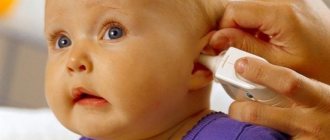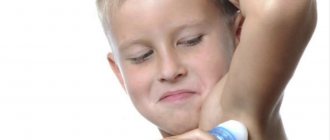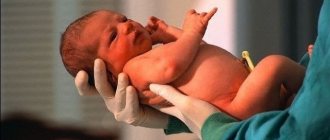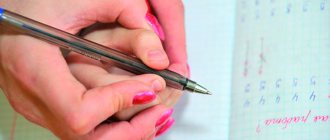What toys does a baby need at this stage?
- rattles;
- pendants and mobiles;
- pyramids;
- sensory mats;
- inserts;
- toys with surprises;
- figurative toys.
On the World Wide Web you can always look at photos of various toys intended for the early development of children, and at the same time read reviews from parents who already have experience using this or that toy (more details in the article: rating of toys for children under one year old by month).
A child in the 6th month of life will play with interest with a tumbler doll - he will definitely enjoy knocking over such a toy. The baby’s imagination is occupied by the unusual reaction of the bright doll to his actions; he will try to figure out why she constantly takes a vertical position, no matter how many times she is turned over. In addition, most of these toys make a pleasant ringing sound when rocked and tipped over.
Try showing your baby a spinning top . The dynamically rotating top will definitely appeal to the little one - even if he won’t be able to control it on his own yet, he will watch how mom or dad does it. Throw an inflatable ball up, and your baby will be amazed to watch its leisurely flight. In order to entertain boys, it is worth trying to roll inertia and regular cars with or without a slide.
How to play?
All 5-6 month old babies are very interested in finding new objects and exploring their capabilities. They will readily master various manipulations with new toys. Of course, with the help of parents, the baby’s potential expands significantly.
You should spend as much time as possible with your child, simply showing him how to play with new toys. Of course, he is still too small to imitate the actions of his parents, but such “presentations” will not be in vain - gradually the baby will learn new skills and will himself repeat all the movements and actions with objects after adults. For this, in fact, these unique “demonstration performances” of parents with various objects and toys are needed.
The only thing you shouldn’t do is rush your baby and get upset that the baby doesn’t start repeating the adults’ actions on the second or third day. He is only six months old, and even the most developed babies acquire such skills only by the age of one year.
Development of motor coordination
The main task of parents at this stage is to inspire the child to transfer toys from one little hand to another. In addition, 5 months is the time to start learning to give and take things at the request of an adult. Vivid examples of such activities can be the nursery rhyme “Funny Ball” and “Running Toy”.
Game "Funny Ball"
For this game you need a not too large bright ball. The baby should lie on his tummy. Hand the baby a ball with the words: “Here! Take it!” When he takes the ball in his hands, start:
- “What a funny ball!” - Lightly squeeze the baby’s hand with the ball and shake it.
- “He’s ready to take off at a gallop!” - Pull the toy a little so that the baby feels the muscle effort.
- “It just begs to be played!” - Twitch the ball in the baby’s hand, enticing him to give it up.
- “It will be difficult to hold on!” - With these words, bring the ball to the baby’s other hand, pushing him to intercept it with the other hand.
- “The ball jumped and jumped, and again it fell into our hands!” State with a smile that the ball has returned to the baby. Continuing the game, for some time shift the toy to one or the other of the child’s hands.
Game "Running Toy"
To stimulate the development of coordination of movements of a 5-month-old child, games where adults move objects in front of his eyes will be useful. At the same time, the baby should look for the object and try to grab it. You should show your baby a new toy at close range, and then move it a little further away, but so that he can reach it. The baby will reach for the toy and even almost grab it, then you need to move the object to the other side, but still so that he can reach it.
Move the object several times, stimulating the baby to still reach the running toy. It's important not to overdo it here. Three or four times will be enough, after that you need to let the baby grab the toy, otherwise he may simply lose interest in the game. The last rule must be applied not only for this game, but also for activities with the child in general.
Developmental activities
Olga Teplyakova, an expert on the intellectual development of children, can tell you what to do with a child or how to keep two children with a small age difference occupied at once. There are many of her classes, recommendations, and answers to parents’ pressing questions available and freely available on the Internet.
Any developmental activities initially relate to the physical and nursing development of the baby. Therefore, before moving on to intellectual exercises, you need to be sure that the baby is physically strong.
A set of developmental activities:
- Do gymnastics and exercises every morning. To do this, it is enough to bend and unbend the legs and arms. You can use a fitball: lay the baby on his tummy, hold him by the legs and rock him.
- 2-3 times a week massage the whole body, starting with stroking, ending with light pats and relaxation.
- At 3 months, begin introducing exercises that encourage the baby to roll over. You should put the baby on his back, throw his leg over the other and try to stimulate the baby to turn over. A few hard studies and he will understand what's what.
- In order for the baby to begin to rise on his forearms and hold his head more often, you can also train him: lay him on his tummy, place bright toys nearby in different places. He will want to look at them, which will make him sit up. This exercise also improves the muscle corset.
- Place rattles and bells in the baby's hands as often as possible. He will look at them and ring. It is best to hang such toys in the baby's crib so that he can reach them.
- Show your baby the reflection in the mirror and say hello to him.
- Sing a lot with the child, say his name, pause so that the baby responds by humming.
- It is necessary to develop tactile sensitivity with objects with different surfaces: hard, rough, soft samples.
- During a walk, if the baby is not sleeping, show him nature, trees, animals, birds.
- Listen to music of different styles. During wakefulness – active, before sleep – calm. Classical music is very good for such purposes.
- Take bright rubber toys and balls with you when swimming. The baby will try to catch them.
Pronunciation of sounds, perception of names
In the third month, the child already understands that he is being addressed and recognizes his name. He also reacts sharply to the intonation of an adult, who creates a feeling of security for him. Therefore, you should always monitor the emotion with which the words are spoken, and under no circumstances should you yell at your baby, much less physically hurt him.
Development of touch and fine motor skills
It is necessary that the baby constantly gains experience from touching objects with a wide variety of surfaces: for example, let him touch a piece of ice and a recently boiled, still warm egg. Give your baby the opportunity to touch objects of different textures (rough and soft, as well as fabrics with and without lint), let his hands splash in warm water, touch soft and hard objects.
Tour of the house
Knead your baby's hands - run your palms over different interior items as you walk around the house with him. Comment on the sensations your child experiences when touching different objects, and at the same time comment on everything you do. So, running your baby’s hand over a terry towel, say: “Let’s touch the towel!” It’s soft and fluffy!” Let him touch the refrigerator: “This is a refrigerator, let’s touch it!” It’s smooth and cold!”, “And this is grandma’s soft scarf.”
Home sandbox
It is very useful for children's little hands to pick up, feel and pour various bulk materials. Set up a kind of small sandbox for your child - any bowl or tray will do. It would be even better to prepare three or four trays for the baby and alternately invite him to rustle cereals or beans in the trays, sort through chestnuts and acorns, pebbles, shells, etc.
The baby will certainly like such games, but there is one problem - he will certainly try to pull into his mouth everything that he touches with his little hands, and even the adult who is nearby will not always have time to stop him. At first, you should try pouring coarse table salt into your baby's tray: once he tries it, he is unlikely to put it in his mouth again. Then there will be a greater chance that the baby will transfer the experience of communicating with salt to other bulk materials with which he will work.
These games will continue into adulthood - you can see their nuances in more detail in the video.
Games with grasping and transferring objects from one little hand to another will help improve the eye-hand connection, which is the basis of all human gestures and actions.
How does a 3 month old baby normally behave?
All important reflexes and skills in young children should be checked by a pediatrician and, if necessary, other specialists. Parents can observe the child's behavior, noting features. A healthy 3-month-old child, lying on his stomach, freely raises his head and examines the situation around him. The first sounds, laughter, smiles are noted. The baby must recognize his parents and express indignation when they are not around. If you put him on his stomach, he will easily roll over on his side. When an adult demonstrates a bright toy, the child certainly reaches out to it with his hands and tries to grab the object that interests him. Young children constantly put their hands or objects in their mouths into their mouths.
As many family members as possible should be involved in communication with the small child. He feels great when carried in the arms. It is important to lead a healthy lifestyle, adhere to the correct sleep, wakefulness and eating patterns, teach your children to do this.
Developing understanding of speech and sounds
First books
It’s hard to overestimate a child’s interaction with his first children’s book. He is already quite capable of sitting on his mother’s lap and “reading” with her: such regular reading will give a rapid impetus to the development of speech, associative thinking, intelligence, and will expand the baby’s worldview. The need for new information is great at any age; children's books will help fill this need - they are the ones who can give the baby new impressions and emotions (we recommend reading: what can you give for a boy’s birthday?).
You shouldn’t think that your baby is still far from understanding fairy tale plots - he already has a long-term memory that will remind him of what he read in a year, two, three
For the past 5 months, the baby has been hearing his parents talking to him. By imitating the sounds that a child makes, adults awaken his interest in continuing communication, thereby developing his speech. When the baby confidently steps towards the age of six months, parents can more actively conduct a kind of dialogue with him: you can come up with exercises in which you would often need to name and show parts of the face and body. At the same time, it is recommended to call things by their proper names - the way they are called in conversation with adults. You should not “babble” with your baby, as this can lead to delayed speech development.
Music
Play soft classical music in your baby’s room or melodies and songs from children’s cartoons that have been familiar to everyone since childhood. It would be very good to put on a disc with a recording of the sounds of nature and the voices of birds and animals.
In conclusion, it is worth recalling that exercise should not be at the expense of health. This is exactly what Dr. E.O. is trying to convey to modern mothers and fathers. Komarovsky, after all, you can teach a baby not only in the apartment, but also by showing him trees, fresh flowers, letting him touch the leaves of different plants with his hands.
A five-month-old baby is no longer a baby. If the baby lives in good conditions and eats properly, at this time he develops intensively and already has a lot. The task of parents at this time is to work intensively with the child, stimulating his motor and cognitive activity. The more attention you pay to your baby, the faster he will grow smarter and acquire new motor skills.
Baby at 5 months
Baby development at 5 months
A five-month-old baby should be able to roll over from back to stomach. Some children at this age also spin in the opposite direction - from their stomach to their back. Also, subject to proper development, the baby should:
- Rise from a position lying on your stomach, leaning on your hands;
- Play with rattles, reaching for them while lying on your back;
- Recognize familiar adults (parents, relatives) and react quickly to them;
- Laugh and babble when played with.
Some children at this age already sit up from a position lying on their stomach, while others crawl “on their bellies.” However, most babies during this period only actively roll over, strengthening the muscles of the back and abdomen.
Attention! If the baby is breastfed and is gaining weight well, you can start complementary feeding no earlier than five and a half months. The first food can be milk porridge or fruit puree. Artificial babies are introduced to additional nutrition a little earlier - exactly from 5 months.
Mental development
During this period, children's senses improve. The child gradually learns to distinguish all the colors of the spectrum, and not just the main ones. The baby especially likes bright colors. The baby fixes his gaze on an object well and can engage with one or two toys for a long time. Also during this period, boys and girls begin to experience an increased need for the company of an adult. Children love to be lifted out of the crib and begin to ask to be held, “manipulating” adults. Babies respond vividly to finger play, reading poetry and singing lullabies.
Physical development of the child
The baby, who will soon be six months old, most likely already has one or two teeth. If there are no teeth yet, the baby's gums gradually swell, so during this period the baby may show increased anxiety and have difficulty sleeping at night. The baby's back and shoulder muscles gradually become stronger. The child pulls himself up in his arms and makes his first attempts to sit. The hand muscles develop intensively: the child no longer clenches his hands into fists, but opens his fingers and examines them carefully. Lying on their backs, children make active movements with their arms and legs, reach out with their toes and try to put them in their mouth. Active preparation for the crawling period begins.
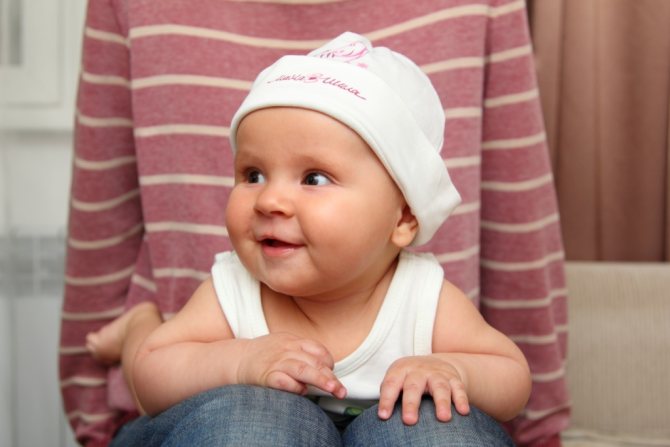
Five-month-old baby can roll over on his own
Emotional and social development
A pediatrician and a neurologist can tell parents how to develop babies at 5 months. Much depends on the individual characteristics of the baby, heredity and temperament. At 5 months, the child does not yet divide people into “friends” and “strangers”. If the baby is treated well, he is not afraid of strangers and willingly goes into their arms. The fear of “strangers” appears a little later, after six months.
Five-month-old babies react very quickly to older children. Therefore, if the baby has brothers or sisters, communication between elders and younger ones should be encouraged in every possible way. However, if the age difference between children is less than 6 years, joint play should only take place under supervision. Under no circumstances should older children be allowed to pick up a baby. A five-month-old baby is an active and restless creature who can easily jump out of the hands of a confused six or seven-year-old.
If parents and other household members often call a boy or girl by name, the baby quickly gets used to this word and readily responds, turning his head in the direction of the sound. Hearing any voice or other sound, the child listens carefully. Five-month-old babies have sensitive hearing, so under no circumstances should you make noise or shout loudly in the presence of the baby, especially while he is sleeping.
Children who will soon be six months old do not like loneliness and constantly need emotional contact with adults. The baby often asks to be held, this is not just a whim - in the arms of an adult, the baby feels protected.
Cognitive development
If parents don’t know what to do with a 5-month-old child, toys that stimulate cognitive activity will help them. Developmental mats are very popular; you can buy them or make them yourself at home. Such a rug can entertain a fidget for a long time. It is a small piece of dense material on which are securely attached:
- Velcro;
- Fastening buttons;
- Rattles and other interesting toys;
- Plastic rings of different diameters.
How to help your baby develop fully
In order to stimulate the active mental and physical development of a baby at this age, it is necessary:
- Monitor the dynamics of weight gain to prevent malnutrition. If the baby is breastfed, you can periodically do control weighings after feeding;
- Talk to your child as often as possible, encouraging him to “answer”;
- Give your boy or girl a variety of age-appropriate toys to encourage fine motor development;
- Do general massage and gymnastics daily, and carry out hardening procedures.
In the summer, you should periodically leave the baby naked without a diaper so that the baby can take air baths.
Interesting. At this age, children love to swim. Parents can show their child how to hit the water with their arms and legs. The baby will be happy to repeat these movements and splash in the bath. Starting from the fifth month of life, you can bathe daily in a large adult bathtub, after washing it clean.
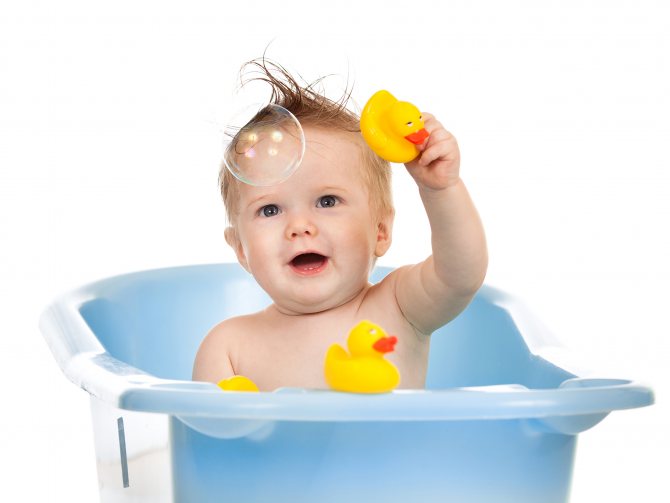
Children love to take a bath
What to play with your baby
There are many activities with a 5 month old baby that are easy for parents. Usually kids react to them with great pleasure. The easiest way to keep a boy or girl busy is with finger games. They promote the development of fine motor skills and develop coordination of movements. The baby gets great pleasure from practicing on a fitball - a large rubber ball. You can roll your baby on a fitball while lying on his stomach. This exercise develops muscles well and motivates the baby to take active actions: pulling up, crawling, turning over.
Development of actions with objects
Playing with a 5-month-old baby at home must certainly include actions with toys and other objects, because at this time the baby is actively mastering the objective world. A baby who will soon be six months old, as a rule, already knows how to:
- Reach nearby objects from a position lying on your stomach and pull them towards you;
- Reach hanging rattles from a position lying on your back and slightly rise when trying to sit up;
- Take small rattles in your hands, rattle and knock them;
- Throw toys out of the crib.
At this age, plastic or rubber toys that are easy to clean are best for your baby. It is not worth giving your child plush animals, because the little explorer will certainly put them in his mouth. During bathing, children's rubber ducks or “sea inhabitants”, from which water flows when pressed, are well suited. The baby will be delighted, repeating this “trick” many times.
The best toy at this age is a good old rattle. Before giving it to a child, parents should make sure that there are no cracks on the toy so that the baby does not get hurt during active actions with the object. During a walk, if the child is not sleeping, rattle pendants that are attached to the stroller will help to entertain him.
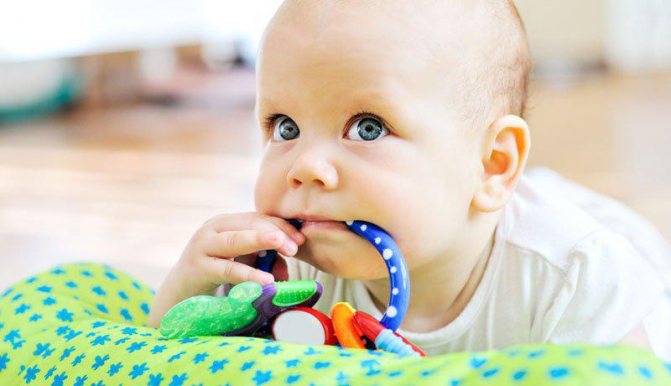
The baby loves to put toys and other objects in his mouth.
Development of movements
To know how to develop a child at 5 months, parents should have a rough idea of his physical capabilities. All children are individual. However, most kids at this age can:
- Rise up, holding the hands of an adult, and briefly maintain a sitting position;
- Transfer rattles from one handle to another while lying on your stomach;
- Stand firmly on your feet if an adult holds the baby under the armpits;
- Hold a bottle or mother's breast in your hands while feeding, creating a comfortable position for yourself.
Parents often do not know at what month of life the child learns to sit, and force him to sit down ahead of time. Pediatricians categorically do not recommend placing a baby on pillows if he has not yet made attempts to sit up on his own. Also, you should not often put your baby on his feet, he is not yet ready for this. On the contrary, any attempt to move on the stomach should be encouraged. Crawling is an excellent exercise; it has a beneficial effect on the overall physical condition of the baby and helps strengthen muscles and bones.
To encourage the baby to move around in space, parents should place him in a playpen or on the floor (after laying down a clean blanket). Next, the baby is laid out on his stomach. 2-3 bright toys are placed at some distance from him. Seeing them, the child will begin to make active movements, trying to push off with his legs and arms. Gradually he will learn to crawl “on his bellies” and will soon stand on all fours. The main thing is to create the right conditions for the baby to move freely and safely within the playpen or fenced area in the room. According to Dr. Komarovsky, most children first learn to crawl, only then sit up from a position on all fours.
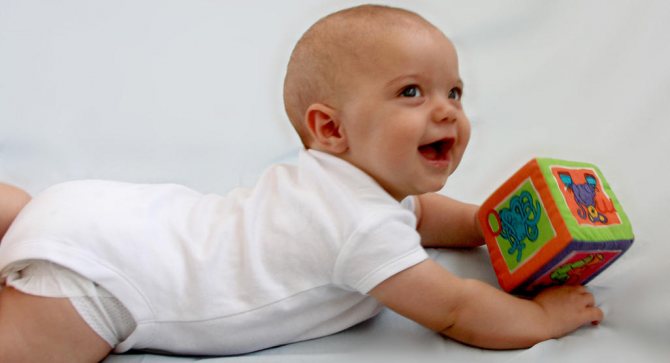
Many babies make their first attempts to crawl on their stomachs.
After six months, a well-developed baby begins to acquire new skills every day: he learns to sit, walk and crawl, and with the appearance of teeth he gradually switches to adult food. In order for a five-month-old baby to safely survive this time of intensive development, parents must support the baby in everything, keep him busy with interesting activities and constantly monitor him. If there is something alarming about your baby’s behavior or well-being, you should consult your pediatrician.
Types of developmental activities with a 2 month old baby
How to develop a child at 2 months? At this age, it is necessary to continue comprehensive classes. Now it is important to focus efforts on strengthening physical fitness, developing motor activity, intelligence and basic senses.
Physical development of the baby
In order for the baby to fully develop at 2 months, comprehensive classes need to be carried out with him. They include exercise, gentle massage and fun home attractions in the arms of parents. The latter will help the baby strengthen the vestibular apparatus.
Charger
In the first half of the day, it is good to include a little gymnastics in your routine. If necessary, you can continue with the head-hold exercise designed for one-month-old babies.
Add others to it - for the development of the muscles of the arms and legs. To do this, you need to put the baby on his back. Next, place your thumbs in his palms and wrap the rest around his wrist. Perform the following movements:
- spread the handles to the sides, and then lift them vertically up - first one at a time, then both at once;
- alternately bend them at the elbows, imitating the movements of a boxer;
- spread your arms to the sides, and then cross them on your chest, first the right one should be on top, then the left one.
- knee bending and straightening;
- "bicycle" movement;
- raising straight legs should be done very gently, the baby should not experience discomfort;
- squats - hold the baby under the armpits and place him on his feet so that he begins to push off, then gently lift him up.
Repeat all exercises 2 times. Then monitor your baby’s reaction and gradually increase the number of repetitions.
Massage
A baby at the age of 2 months should be massaged very carefully, using stroking movements. The following technique helps well in overall development. The child should be placed on his side and the whole palm should be stroked along the spine.
Impact on the vestibular apparatus
Mom or dad can have fun activities with their baby, simulating flying and riding an elevator. In the first case, the baby needs to be carefully placed in your arms on his stomach and smoothly carried around the room. To simulate an elevator, you should take his armpits facing you and slowly raise and lower them. Be sure to make sure your baby holds his head well. Don’t forget that he should like such activities. Start doing them very slowly, carefully and gradually so as not to frighten the child.
Stimulating a child's intellectual abilities
Take large color pictures with images of animals or objects. Show them to your baby from a distance of 50 - 70 cm and at the same time name what is shown on them. Speak the words slowly and clearly.
Play the game "Mirror" with your child. Look at him and repeat all his gestures, facial expressions, sounds. Gradually begin to slightly modify all this. So, it is useful to add individual syllables from simple drawn-out sounds. Soon you will notice that the baby copies you too. This way you can teach him to speak faster.
Development of vision, hearing and fine motor skills
At 1 month, the baby begins to develop hearing using a rattle. They rattle it, now from one side, now from the other. Gradually, the baby learns to distinguish where the sound comes from. At 2 months, you can complicate the game by taking two rattles with different sounds.
At the same time, use another method - put colored bracelets with bells on your baby’s wrists. You can also place rattles, rattling balls, or other toys that make sounds in his hands.
To develop vision, show your baby mini-performances. To do this, use bright hand-held dolls. Remember that at this age, presentations should be short and extremely simple.
Patchwork rugs sewn from different types of fabrics and bags filled with all kinds of fillings will help develop fine motor skills and tactile sensations.
Hang a music mobile above your baby's crib and play it for a few minutes a couple of times a day. Don't forget to develop your hearing and instill good taste in your baby from a very early age, including calm classical music from time to time.
To ensure your baby develops quickly and fully, do different activities with him every day. Be sure to choose a time when he is in a good mood. If something is bothering your baby and he refuses to play, don’t insist. Joint activities with a child not only benefit him, but also help establish close contact with parents and give a lot of positive emotions.
Just a couple of decades ago, the question of training a 2-month-old baby would have only caused bewilderment: is such a small child capable of anything other than lying on his back in tight diapers? But modern pediatricians insist: at 2 months it’s time to start developing the psychomotor, visual and auditory functions of a small organism. For these purposes, special games and gymnastics are used. You can “dilute” everyday chores with simple activities.
How to develop a baby at 5 months
How to work with a 5 month old baby. What games can you play with a 5 month old baby? Games for a 5 month old baby. Toys for a 5 month old baby.
How to develop a child's vision, hearing and motor abilities at 5 months.
The surrounding space becomes more and more important for the child. And if you didn't set up your play area last month, get it ready now. It is very important that the surface on which the child will be located is level and also protected from drafts, if this is a space on the floor. There should be enough space for the baby to learn new skills in movement and manipulation of toys.
Toys for a 5 month old baby
The selection of toys this month can be significantly expanded . These can be rattles with handles, rings, rubber animals. When taking them out to play, immediately place them at a certain distance so that the baby tries to crawl to them and get them, this will activate his movements.
Well forgotten old
- Games that have deep historical roots are good for this age period, for example, “magpie-white-sided” - this is both “training” for the baby, and massage, and a way to stimulate certain areas of the brain.
- “Ladushki” train attention, coordination functions and memory.
- “Peek-a-boo” is often a great favorite among children; the game can not only entertain your child, but also train the cognitive functions of the brain. In the world of modern technology, these simple but useful games are undeservedly forgotten.
One of the most exciting activities for a little one at three months is exploring his limbs. He is able to devote quite a long period of time to looking at his hands or playing with his feet. In order to turn play activities into educational ones, mom will need a little imagination. Colored socks with different animals or faces will be great helpers. They can be worn both on the feet and on the arms.
Some children enthusiastically look at colorful fabrics, some actively touch them, while others simply take them off, training coordination and developing precision of movements. However, when conducting useful and interesting activities with a three-month-old baby, it is important not to overdo it. If the child is tired, wants to sleep, or is simply not in the mood for classes, reschedule them for another time.


